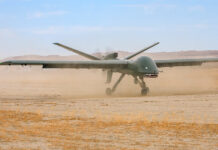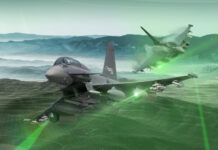Electronic Warfare (EW) in Ukraine has been a critical enabler for both sides of the war in Ukraine, with each scrambling to adapt to modern battlefield possibilities within the electromagnetic spectrum. This domain has been used for a variety of purposes, including gathering information, target locating/positioning, disruption, deception, and even downing UAVs. While EW has been a common sight on many battlefields of the 20th and 21st centuries, it has perhaps never been as sophisticated, or as target-rich a domain as it is today in Ukraine. To explore its role in this war, during the Association of Old Crows (AOC) Europe Event from 15-17 May 2023, ESD sat down with Iaroslav Kalinin, CEO of Ukrainian EW specialist firm ‘Infozahyst’ to discuss the role of EW and communications in shaping the conflict so far, including Russia’s performance in this sphere.

Credit: Infozahyst
Kalinin explained that Infozahyst was founded back in 2002, and the company’s name approximately translates to ‘Information defence’. Initially the company operated on providing information protection for high-level government officials, such as the cabinet of the President of Ukraine. However, following the fall of the Yanukovich Government and Russia’s annexation of Crimea in 2014, Infozahyst switched to developing radio monitoring and communications intelligence (COMINT) equipment. Then as recently as 2020, the company expanded its capabilites, adding the development of electronic intelligence (ELINT) and electronic support measures (ESM) to their portfolio.
Kalinin joined the company in 2016, when the company began work on developing their ‘Plastun-RP3000’ man-portable direction finder (DF), and later its extended-range, containerised truck-mounted version, the Khortytsia-M. These developments caught the attention of the Armed Forces of Ukraine (ZSU), who began to procure both, with Plastun-3000RP entering service in 2016, followed by Khortytsia-M in 2018. By the time the War in Ukraine broke out on 24 February 2022, the ZSU had approximately 300 Infozahyst-developed systems in service, primarily comprising the Plastun and the Khortytsia-M, according to Kalinin.
Since the war broke out, these and other systems have been an important tool in Ukraine’s arsenal, having been used for locating enemy positions and assisting artillery targeting, intercepting communications, and counteracting unmanned aerial vehicles (UAVs), among other tasks.

Credit: Infozahyst
Throughout the ongoing War in Ukraine, much of Infozahyst’s focus has been on the lower-frequency portion of the electromagnetic (EM) spectrum. According to Kalinin: “the challenge in this war now, is working against low-band emissions” adding that: “in my experience, really few of the…international companies [are] really good at addressing this challenge.” He noted that: “no one take care about this particular band for really long time, like band from 25 or 20 MHz up to 50 MHz…not for the field trainings, but for the real work with the real world radios.”
Hunting Over the Airwaves: The Utility of Direction-Finding
With wireless communications such a critical component of modern warfighting, the need for ELINT, COMINT, and direction finders has greatly increased in importance over the past couple of decades. Kalinin recalled: “I spent like in total, more than eight months on the frontline, starting from the 2014. And from this time, I have multiple stories, how helpful [it] was having the direction finding system right in the hand of the commander. So he understood exactly where exactly enemy plan to do…some activities, even if we failed or intercept some communication, but still he knows the exact grid area where [there’s] going to be operation.”

Credit: Infozahyst
Infozahyst’s Plastun-RP3000 portable DF system is capable of direction finding Radio Frequency (RF) and Microwave band signals from 25 MHz to 3 GHz, out to approximately 15 km (or 45 km in the case of the longer-range Khortytsia-M), with an average instrumental error of >0.5°, and root mean square (RMS) error of >3°. Furthermore, as the distance between DF and signal source decreases, so does the circular error probable (CEP). The table below illustrates approximate CEPs at various ranges, though readers should bear in mind that these are approximate figures, since accuracy is also affected by the frequency of the detected signal:
| Distance from DF to Emitting Target | Approximate CEP |
| 45 km | 393 m |
| 35 km | 305 m |
| 25 km | 218 m |
| 15 km | 131 m |
| 10 km | 87 m |
| 7 km | 61 m |
| 5 km | 44 m |
While most of the above CEPs are still too high to allow precision targeting by themselves, they can nonetheless offer various options to a force, depending on the tactical scenario they find themselves in:
- Artillery fires directed at lower CEPs, may be sufficient to permit engaging the target when combined with other means such as satellite imagery and pattern analysis over time. Kalinin provided an example from the defence of Kyiv: “when you have enemy mortar unit, which [is] constantly running from position to position…but they are lazy…they are just simply switching between like say four positions and you already get the satellite imagery and you’d exactly know X, Y [coordinates] of this position. And once immediately you get interception, when battery start preparing to fire, you [are] already ordering your artillery to that exact X, Y, even if you don’t have the UAVs or something, and you do the strikes even before they [can].”
- Artillery fires directed against higher CEPs, may be sufficiently close to cause the enemy to reposition out of concern that their position is known. While this is more a psychological effect than a material effect, it can nonetheless still be useful depending on the scenario, such as counter-battery fire. In this vein, Kalinin recalled the early days of the war, where Ukraine managed to halt the Russian advance into Kyiv: “it’s sometimes inefficient because at that time we didn’t have any precise artillery systems. Sometimes it was just a fear factor, because even if 200 m from you [is an] exploding 152 mm shell, you would be considering changing position. Even losing your [artillery] barrels, but you won’t be conducting the artillery strike anymore.”
- When paired with more accurate cueing by reconnaissance assets such as UAVs, DFs can speed up precision targeting cycles considerably, by greatly narrowing down the search area for the UAV. This would mean hostile emitting targets can be detected and engaged much more quickly compared to searching out enemy positions without a semi-defined target area.
A Plastun set comes in the form of two man-portable semi-sets. Each semi-set weighs 39 kg and consists of a large duffle bag containing the mast and antenna, as well as a rucksack carrying the battery and associated electronic equipment. The operator uses a ruggedised laptop connected to the electronics via a wired datalink so as to avoid unnecessary emissions. The wired link is 50 m long, allowing the operator to work at a safe distance from the antenna in case it is located and targeted by enemy forces. Additionally, if paired with a ‘master’ semi-set, the second ‘slave’ semi-set can be operated remotely, thereby decreasing the crewing requirements. A Plastun semi-set can be assembled in just 20 minutes, and once activated, can operate continuously on battery power for up to 8 hours. An Infozahyst representative stated that the set could also be connected to an electrical power generator to extend its operation time.
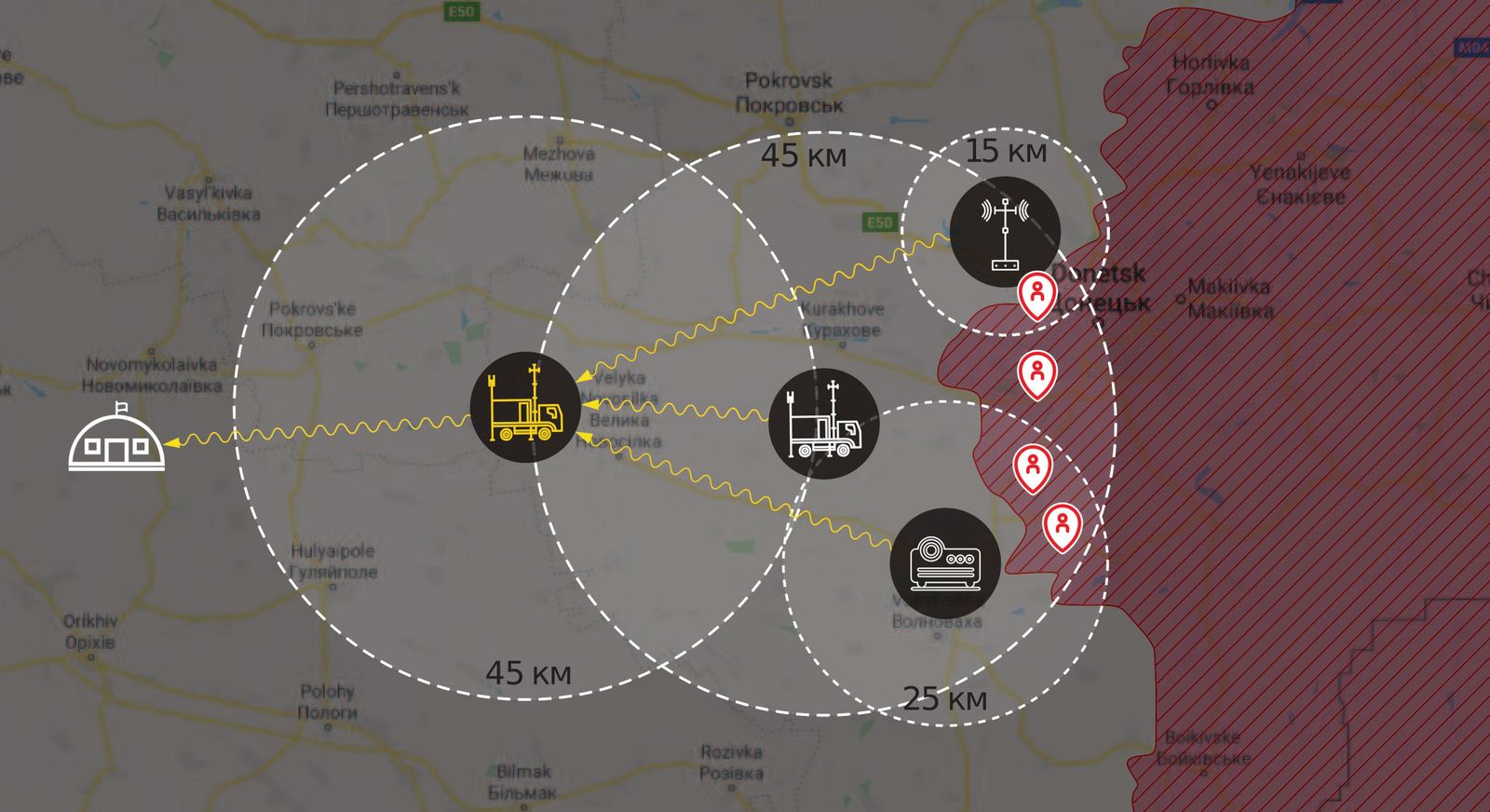
Credit: Infozahyst
The basic operating principle by which these antennas function under is that they are usually placed at a specified distance several kilometres apart from one another, and connected either by coaxial cable or one of two possible wireless connection options, forming a bistatic antenna. These antennas then passively detect incoming signals within their area of responsibility and classify them. Since the distance between the two antennas is known, by exchanging information and comparing the respective angle of arrival (AOA) and time difference of arrival (TDOA) between the two antennas, the direction of the incoming signal can be triangulated using trigonometric principles. Kalinin noted that the system was small and light enough to easily carry and mount on high ground, in order to gain the best range performance from the system.
A further major factor behind Plastun’s design is cost, Kalinin noted that Ukraine’s wide use of SIGINT and COMINT systems “goes in contrast with the strategy of the NATO countries when you have the SIGINT unit, one or two for our whole army, and you don’t have the own direction finder for every brigade”. By contrast, he noted that “in our army, we even sometimes have multiple systems for one brigade. So we can easily solve the task of the multiple sensors in one. And if some sensor doesn’t see it, other sensor will.”
At the tactical edge, DFs can provide commanders with a highly valuable tool for detection of enemy presence and tracking their movements over time. While DFs can to an extent be rendered less effective by practicing good communications discipline, avoiding them entirely is extremely difficult, especially given that modern warfare is highly reliant on communications and networked systems, and this problem becomes more pronounced the larger the formation. Simply put, there is no escaping use of the electromagnetic spectrum.
Radio Retaliation: Defeating Russian UAVs with COMINT
Among the more impressive wartime feats performed by Infozahyst, Kalinin stated that their company has succeeded in being able to tap into the signals of some of Russia’s UAVs. ESD is not at liberty to disclose the model(s) of UAV involved, or to provide more details on the techniques and methods used by Infozahyst, however, some small details of a particular instance can be shared.
In this particular instance, Kalinin stated that Infozahyst were able to develop the capability to tap into the signals of a specific model of Russian UAV, and by doing so, were also able to build soft-kill electronic countermeasures against it. These combined measures were reportedly so effective, that following a number of losses, the Russian armed forces stopped using this model of UAV entirely. This is an extremely impressive achievement, removing a threat from the wider battlefield.

Credit: Infozahyst
The extent of what is possible with modern COMINT against UAVs is quite remarkable. According to Kalinin, by tapping into the signal: “We got the position of operators, UAV, their forces, part of job, their UAV, if they run with turned on camera, we even do that part of recording once UAV getting to our position. So, yeah, they understood that this is a failure.”
As well as demonstrating the truly impressive ingenuity which can come from a determined defender, Kalinin’s account is a stark reminder of the importance of using secured communications at all levels, and the harsh consequences of failure to do so.
Ears in the Sky: Developing an Aerial ELINT/ESM System for the Modern Battlefield
Going beyond their existing portfolio, Kalinin revealed that the company was in the process of developing an aerial ELINT/ESM reconnaissance platform for operating at medium to long ranges. The system is known as ‘Gekata’, named after the ancient Greek goddess Hecate. Kalinin explained the envisioned role for the system is to provide situational awareness of enemy aerial surveillance radars stationed along the frontline, all the way out to and strategic long-range radars.
According to Kalinin, this task is relatively simple when dealing with coastal radars at ranges of around 200-300 km, due to ground wave propagation (in which radio waves propagate parallel to a conductive medium such as seawater), resulting in relatively low signal losses even over fairly long distances. However, since dry land is a dissipative (lossy) medium, detection of propagating signals is much more difficult, and would require a receiver to be placed at a reasonable altitude, or to rely on obtaining signals which have been refracted from the ionosphere. The problem with relying on ionospheric signals, Kalinin explained, is that “in order to detect this emission, you need to have a really big antenna and it’s harder to manoeuvre with that. You’re immediately the target – satellite imagery, SARs [Synthetic Aperture Radars] will much or less immediately spot you…and the human intelligence, [will] easily recognise the system. So it’s not that safe to operate that kind of equipment in this kind of conflict.”

Credit: Infozahyst
As such, the more prudent alternative was to mount this detection equipment on a flying platform, but these came with serious risks given the nature of Ukraine’s contested airspace. Kalinin described the process of testing such a system with a helicopter, and explained how the risks of being targeted increase rapidly as the platform gains altitude. Even at very long ranges of approximately 120 km from the enemy sensors, Kalinin said “for helicopter…you have like 15 minutes” before the platform was at serious risk of being engaged.
Elaborating further, he said: “So you’re getting [to] the altitude of 500 m, you’re getting spotted by enemy radar, long range radars. Once you climb to the 1,000 m, you’re getting the emission from the airborne radar from the fighter. Once you get to thousands [of metres], you see the very wrong signals from the enemy airborne radar, and no one tested further” he said laughing, before smiling and adding: “The pilot said, “okay, okay, let’s go below that tree”, and usually it ends up with the extremely high-speed landing”.
As such, the selection of a relatively small platform became necessary to avoid such attention, Kalinin noted: “We had that experience, and it doesn’t work for helicopters. Same story for the bigger platform, like AWACS. If Ukraine had the Bayraktar UAVs, it’s sometimes the same problem. So you have to be smaller than that and cheaper than that.”

Credit: Infozahyst
Aside from being cheaper and more difficult to detect, Kalinin also noted that such small platforms also make far less-tempting targets for enemy long-range weapons: “even if it was detected, it’s hard to launch and a questionable reason to launch a long-range air-to-air missile like R-37M on this distance…100 and something kilometres from the frontline. So it doesn’t look like a reasonable target for enemies.”
As such, the company decided to use the relatively small PD-2 UAV from Ukrainian company Ukrspecsystems as the host platform for their Gekata ELINT/ESM reconnaissance system. The platform is available in three configurations – a vertical take-off and landing (VTOL) variant provided with four lift rotors for take-off and landing, and a pusher prop for level flight, or a two conventional take-off and landing (CTOL) configurations (4 m wingspan and 5 m wingspan versions), which are only provided with a pusher prop for propulsion. The manufacturer claims that the system’s modular design enables it to be converted from CTOL to VTOL configuration in just 15 minutes. Gekata is due to use the VTOL configuration, which in terms of performance, has a service ceiling of 4,500 m, a maximum range of 800 km at a cruising speed of 100 km/h, giving an endurance of 8 hours, while carrying a maximum payload of 11 kg. The UAV ground control station comes with a communication antenna tracking unit designated ‘AT-1’, which facilitates communications with the UAV out to 200 km on the primary datalink, or 150 km on the backup datalink.
Under Infozahyst’s operational model, the complete Gekata system would comprise eight PD-2 VTOL UAVs fitted with Infozahyst’s ELINT/ESM package, and a ground control and data collection station. The UAV payload consists of an omnidirectional receiver antenna in a cylindrical housing fitted to the UAV underside, just aft of the nose, along with on-board and signal processing and classification systems. This ELINT/ESM package has an operating frequency range of 2-18 GHz, and is capable of measuring both angle of arrival (AOA) and time difference of arrival (TDOA) of intercepted signals, as well as processing up to 2.5 million pulses per second to protect it against high pulse repetition jamming attacks. The ground station is intended to control up to four UAVs at a time, with four kept as in reserve. These latter four allow the user to rapidly re-establish coverage when the first four head back to refuel, or can serve as replacements in case of attrition.

Credit: Infozahyst
The fact that Ukraine is looking to small and cheap UAVs over larger and more capable platforms is also somewhat telling of the high attrition rate such platforms of all classes have suffered in Ukraine. When facing an opponent with numerous and relatively capable air defence systems such as Russia, the planning expectation seems to be that such platforms will not last long. As such, their best bet for surviving is to draw as little attention to themselves as possible, and to have backups available for when platforms are lost.
Falling on Deaf Ears: Russia’s Communications Woes
A key theme during ESD’s conversation with Kalinin, were Infozahyst’s assessments of changes to Russian communications observed over the course of the war. The paucity of the Russian Armed Forces’ communications has been a well-documented thread running through much of the war, and according to Kalinin: “They failed, in my opinion, communication at the start of the war.”
This failure of communications resulted in numerous problems, including frequent interception of Russian Armed Forces’ communications, leading to discovery of their positions on the defensive and loss of operational surprise on the offensive, as well as many cases of officers being out of communications reach of their subordinate units, leading to organisational chaos during key moments. At an even more basic level than these, Kalinin explained that poor communications had also negatively impacted the accuracy of Russia’s artillery: “So in Russian, they go through the books, like classic books, like “target 150 metres, two shells, full battery, this kind of shelling, fire!”…It doesn’t work like that. First of all, all the shells from the first fire [mission] go completely other side, because everyone didn’t hear you clearly on the radio…and no one admitted [it].” Consequently, Kalinin noted: “So…because of efficient intercommunication, we were two steps ahead of start of firing”.

Credit: Arms of Russia Information Agency
Although the Russian armed forces have not stood still, and definite progress had been made, Kalinin was keen to emphasise that many of the changes seen so far have been fixes of previous mistakes: “it’s not like evolving, it’s just fixing. So they managed to fix it in the middle of summer last year [2022], less or more. And they started finally get out of the pit with their Soviet-era radios then. But they didn’t manage to fix it completely.”
Since “fixing” some of their early problems in the summer, ESD asked Kalinin whether the overall challenge of combating Russians communications had become more difficult in early 2023, to which Kalinin responded: “I would say staying same or simplifying…our forces managed to destroy most of the less or more modern systems like Akveduk. And [the Russians] have no choice, but switching to the civilian radios, like DMR [Digital Mobile Radio] protocols from the Chinese Hytera system…for instance, or other Chinese manufacturers. But this is not a systematic move – this is more volunteers who supply Russian army with those systems, and…by private organizations such as Wagner [who use] this station. And again, because of nature of this protocol, it’s only tactical level solutions.”
From Kalinin’s account, many of the Russian Armed Forces’ tactical communications fixes seem to be occurring in a fairly patchwork and localised fashion, largely through the initiative of individual units than a systematic and concerted effort. Looking beyond the tactical level, Kalinin noted: “On the operational or strategic level, they’re still using the approach they have way before the war. But again, it’s not something same for all the forces and all the positions. In some units, they start using the new systems [Azart] to communicate. But again, it’s more initiative work than [a systemic] approach.”
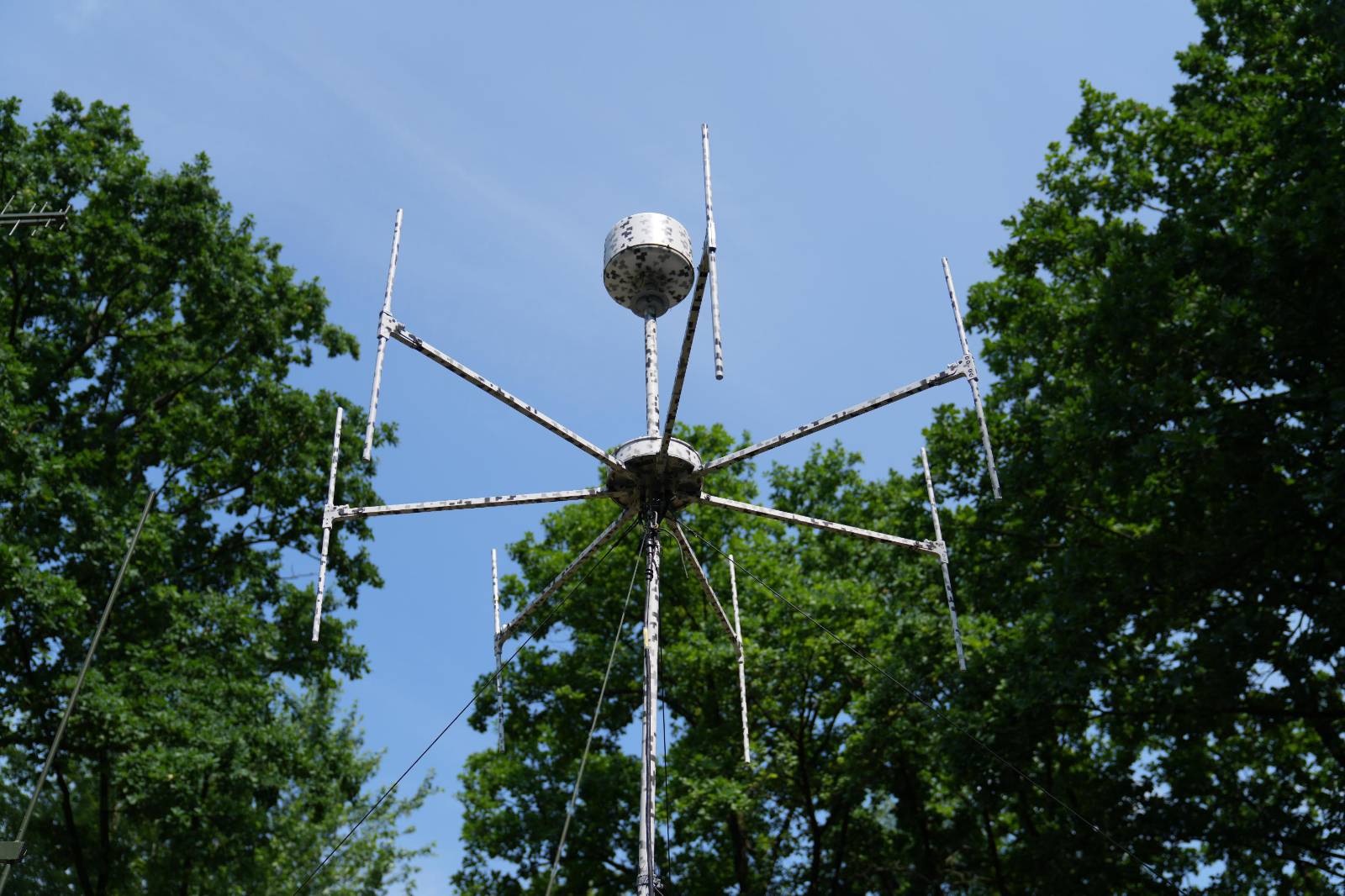
Credit: Infozahyst
To a large extent, the adoption of ‘lessons learned’ and adaptation of Russia’s armed forces seems to be unevenly distributed. Some may have better equipment, others more experience, or better training, or more diligent commanding officers. To be fair, this is not a particularly new phenomenon in any armed forces, however the unevenness seems to be particularly pronounced in Russia’s armed forces, where even before the war, capabilities could vary greatly from unit to unit, at least on paper. Beyond these patchwork fixes, Kalinin noted that in some areas there were signs of more noteworthy progress being made, particularly when it came to Russia’s newest radio ‘Azart’.
The Rise of Azart
The most modern radio family in service with Russia’s armed forces is the ‘Azart’ sixth-generation family of Software-Defined Radios (SDRs), developed by Russia’s NPO Angstrem. They have been gradually trickling into service since around 2014, when a batch of R-187P1 handheld radios was delivered to the Central Military District’s Peacekeeping Brigade, the 15th Separate Guards Motor Rifle Brigade, based in Samara.
Aside from the R-187P1 ‘Azart-P’ short-range (up to 4 km range) handheld variant, with an operating frequency band of 27-520 MHz, the family also includes the R-187N ‘Azart-N’ medium-range (up to 12 km range) vehicle-mounted, and R-187BV ‘Azart-BV’ longer range (up to 40 km range) vehicle-mounted variants. However, it should be noted that only the handheld version has been noted in service, with even Russia’s more modern vehicles such as the T-80BVM and T-90M main battle tanks continuing to use the older Akveduk family.
Beyond these, NPO Angstrem has also exhibited an improved handheld variant, known as ‘Azart-2’ at a closed pavilion during the Armiya-2021 defence and security exhibition at Kubinka in August 2021. Shortly after it was shown, some Russian sources speculated that this newer version could enter service with the Russian armed forces as early as 2023. However, little has been heard about this variant since the war broke out in February 2022, and given that not even the first generation of the Azart family has seen full adoption, it remains doubtful that this variant will enter service in meaningful quantities anytime soon.
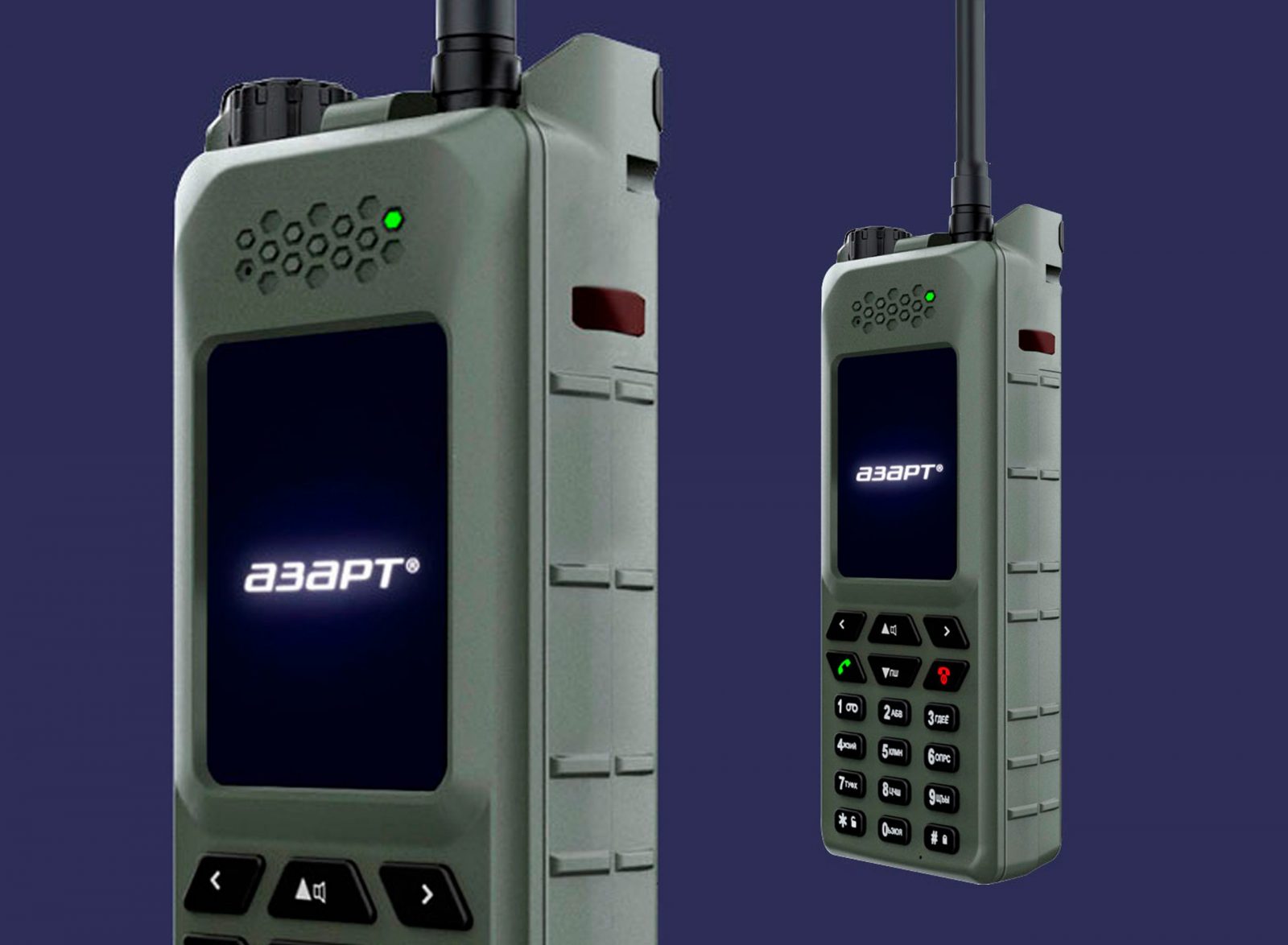
Credit: NPO Angstrem
Over the course of the conflict, Infozahyst have become deeply familiar with the Azart radio family, thanks largely to managing to get hold of captured samples for study and analysis. During ESD’s discussion with Kalinin, he painted a fairly nuanced picture of the radio, pointing out both strengths and weaknesses, as well as noting some of the changes to it observed over the course of the conflict.
Azart saw more limited use during the early phases of the war, but has now started to become much more commonplace in Russian service, albeit not for all units. According to Kalinin, part of the reason for its low usage was that some units had problems using the system, leading to patchwork usage and various units falling back on simpler systems for communication. He explained: “It’s supposed to replace old Akveduk, but it didn’t happen for whole army. It happened for the Central District [CMD], but for Southern District [SMD], it doesn’t look like finished process. And [at] the start of war, they heavily use Akveduk systems. And again, Central District failed to use the Azart system – they have it, but they failed to use it [for] different reasons. That become [an] opportunity for us, because they fall back to their analogue systems to communicate.”
When ESD asked whether the root cause of these problems were hardware or training, Kalinin responded: “That was the multiple factors. One of the lack of training, one of the hardware issues.” Expounding on the hardware issues, Kalinin stated: “So they have a brilliant, very good design station with a really poor, inefficient antenna”.
However, he noted that the Russians had been taking measures to improve the radio, stating “now they fixed them”. When asked if this fix included adding newer antennas, Kalinin simply said “yes” before expounding: “it was a simple mistake, obviously, but it was there. So some of the commander find a better antenna of their own, some unit…they managed to put multiple station in the retranslator mode onto UAV to extend the coverage of the radio links. So they’re doing whatever they need to somehow organise their radio communication. They [had] very significant issue with that, I would say, at least at the start of war. Now, they more or less, they fix it – some issues with Azart and now they are massively use it, but still you might notice Akveduk, Arakhis systems and DMR systems.”

Credit: Rosoboronexport
As such, the Azart of today seems to be a different beast to the version Russia started the war with, and one sign of the Russian armed forces’ increasing confidence with the radio is the rise in its usage. Kalinin noted: “they changed the hardware design slightly…they definitely will fix problems they spotted in the field, and we see the signs of this process. And one of the major signs, they’re more and more using the Azart systems as a main system. So yes, they managed to fix most of the problems.”
Benchmarking Azart’s Performance
When asked to give a comparison to a modern and capable Western system in service with Ukraine’s forces, the L3Harris Falcon IV family, Kalinin responded:
“I didn’t have experience with Falcon IV, I only have experience with Falcon III. I would say it’s completely different matters… [Falcon is] pure frequency hopping, they exactly do what they state. For Azart, it was much longer story. I believe they shown to their commanders initially a working concept, which was built completely only with TETRA protocol. So it’s fixed frequency, no frequency hopping, nothing like that, just commercial grade protocol. And then they slowly but surely come to the frequency hopping mode, at least what we could call frequency hopping, and then they develop it even further, so [now] they have the mesh mode. I believe from the perspective of vulnerability to electronic countermeasures, it’s harder to attack Falcon. Azart is more vulnerable from this perspective. However, the Azart station has more advantages, because I didn’t see personally [the] evolution of the physical layer of the Falcon.”
When asked to clarify what changes Infozahyst had observed at the physical layer, Kalinin clarified:
“When you see the station [as an] unknown emission on the spectrum, first of all, [you] have to identify it. You could identify [it] by signature, hop lengths, whatever parameters. So if we talk about Harris, it’s pretty much the same system with the known modes and it’s not change significantly its behaviour. If we talk about Azart, it significantly changed how [the] emission looks like, what’s inside the emission, so on, so on, so on. So it might become completely new station in [the] near future. So having the same hardware, they completely change how it looks in some perspectives, with new firmware updates, for instance.”

Credit: L3Harris
Regarding this pattern of rapid evolution ESD asked: “you think the Azart is evolving faster and adding new capabilities faster?” compared to radios such as the Falcon family. Kalinin responded: “Looks like that,” adding “we cannot name changing [the] antenna as a hardware [change] – by definition it is – but let’s name it ‘fixing the problem’. But from the perspective of [the] software/firmware layer, yes, they are moving forward much faster.”
A Fancy Thing in the Hands of a Barbarian
Despite its strengths and the present pace of its evolution, the Azart family has faced criticism for being complex compared to its predecessors. ESD asked Kalinin his opinion on whether he considered the radio to be designed more for use by engineers rather than for soldiers. Kalinin’s response was somewhat surprising: “For Generals” he said, later adding: “it was designed by brilliant engineers, to be shown to generals.”
In this vein, Kalinin noted that the radio had some truly “questionable features,” particularly compared to Russia’s earlier ‘Akveduk’ family of fifth-generation radios, elements of which started entering service with the Russian Armed Forces in the late-1990s/early-2000s. Comparing the two, Kalinin said: “I saw multiple user interface of radios, and I want to state, Akveduk has [a] ‘boots-driven’ user experience and interface. What I mean [is] you can operate with the radio by your boots, it has durable everything, and…you cannot press [the] wrong button, physically. With the other system [Azart], you have beautiful TFT display, colourful, and you have the infrared access port.”
When asked about the purpose of the infrared access port, Kalinin burst out laughing and said: “I don’t know!”, and with wry smile, he added: “I know, but…I still cannot imagine [a] real-world case to use it.” Indeed, it seems difficult to imagine why such a feature is needed in a tactical radio, aside from the questionable utility of allowing soldiers to use it for changing TV channels or turning on building air conditioning units. Alongside this feature, Kalinin highlighted that with Azart, “you can change the wallpaper on the screen – THAT’s a good radio!” he joked, “I don’t see Falcon IV, but I bet they don’t have feature to change the wallpaper!”
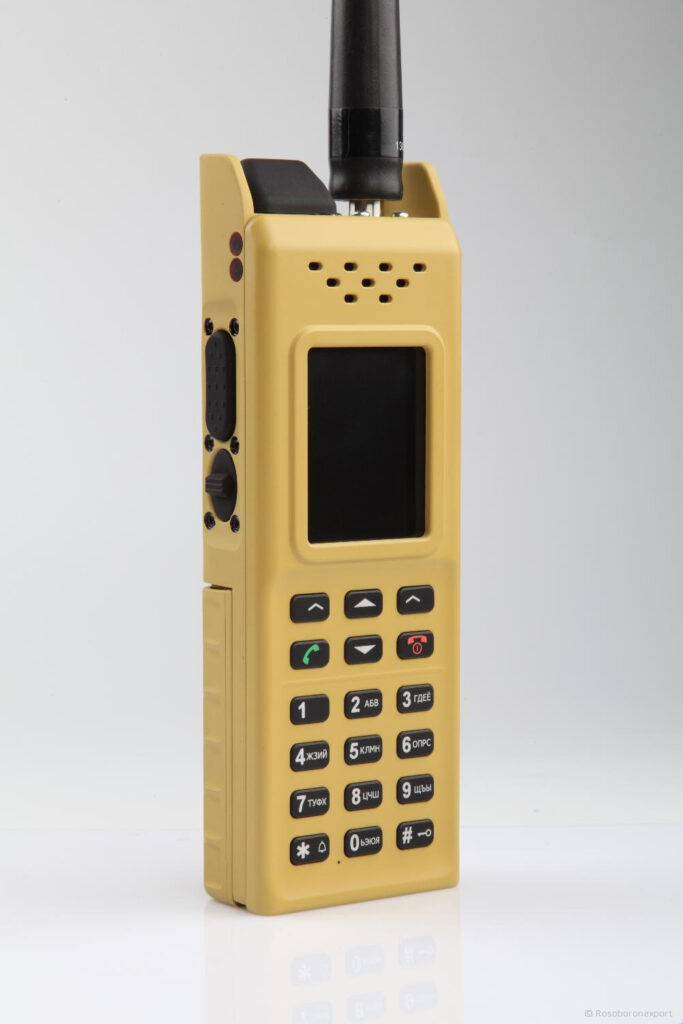
Credit: Rosoboronexport
Such questionable features are indicative of over-engineering and unnecessary complexity within the design. A complaint previously levelled at the Azart was that it was too complicated for many average Russian soldiers to use. Here, another Infozahyst representative noted that even among those Russian soldiers using Azart, many were not even close to using the full capabilities of the radio, and by way of example stated that they had a habit of using just eight out of 256 possible channels, and speculating that the main reason for this was laziness.
When questioned on the usability of the Azart, Kalinin laid the blame primarily on the level of training and education of the Russian soldiers: “you need to understand that here you can raise up the engineers who could develop…state-of-the-art radios, but if your country failed in preparing soldiers, [with] basic education, general knowledge, school or knowledge institution, university… and you’re giving this sixth-generation radio, SDR – fancy thing, in the hands of barbarian – you shouldn’t be expecting much from this guy. He has to have engineering knowledge, understanding what he’s doing, the station itself. Yeah, they are not using the full spectrum of features of the station, but it’s not the failure of the station or engineers for the station, it’s particular failure of units which doesn’t have enough training, time for preparation…multiplied by issues with the station itself, multiplied by very poor education of the end user.”
When asked about Russia’s industrial capability to continue production of the Azart family despite the heavy sanctions regime on the country, Kalinin stated: “I believe that they are still in production, even though they’re using…national instrumental chips, they avoid the sanction and restriction in buying those chips, because this is something, I believe, industrial grade or even civil grade chips. So it’s not that easy to control how these chips is, where they’re supplying [from]. And they have a lot of allied countries which [are] buying those chips and supply to the production. So yeah, I think they will be in the production till the end of [the] war.”
Flooding the Receiver: EW Threats
With regard to the Russian jamming threats faced by Ukraine, Kalinin noted that sometimes even relatively simplistic jamming techniques can be very complicated to deal with. By way of example, he cited Russia’s ‘Rychag-AV’ system developed by the Concern for Radio-Electronic Technologies (KRET), and is mounted on the Mi-8MTPR-1 helicopter variant. According to Kalinin, the system “could be used for just overloading ESM systems, because it generates simply 500,000 pulses per second. It’s just too much.”

Credit: TV Zvezda
According to Kalinin, the problem lies in the fact that each pulse needs to be processed by the receiver before it can be rejected, and every receiver has an upper limit for how many pulses it can process in a given span of time. As such, an airborne system such as Rychag-AV with a very high pulse repetition frequency (PRF) can pose a significant problem for ELINT systems, even without having to use particularly high-power emissions – according to Kalinin “it’s airborne, so 100 watts [is] enough to do the trick.”
Expounding on the problem, Kalinin said: “You can’t just simply ignore it. It would be definitely pulse on pulse, giving you additional pulses to be processed. And many of the systems on the market are limited by 1 million pulses per second. So…if you have one or two systems like that, you will have overload of the data on the receiving side.”
By way of example, Kalinin described a simple scenario: “So in case if you have two fighters in support of two systems with Rychag, you will spot around up to 1 million pulses per second. And out of the shelf system of the ELINT, for instance, one of the big company…could process 500[thousand].”
According to Kalinin, the problem remains technically very difficult to solve: “It’s like a DDoS kind of attack…Even if you have separate pulses, processors, encoders, whatsoever, you simply would be overloaded with the amount of the pulses.”
Russia’s emphasis on EW has been a feature of the armed forces since the end of its 2008 war with Georgia. From that point, Russia invested heavily into EW as a means of countering NATO’s network-centric warfare, and such systems have proliferated widely within their armed forces, with Russian manoeuvre brigades gaining an organic electronic warfare company.

Credit: KRET
At the start of the War in Ukraine, Russia’s EW units failed to be particularly effective, but this was in large part down to the fact that many of these systems were ground-based, and had to first get into position to work effectively without fragging their own side’s communications. Yet, as with many of their capabilities such as air defence, their EW units in the War’s opening phase were often limited by where they could advance to by logistics, or simply stuck in traffic jams. However, once they were able to reach their required positions, their effectiveness increased considerably. By contrast air-based jamming systems such as Rychag-AV faced fewer such operational limitations.
Answering the Call: Lessons to Learn
With Russian communications gradually improving, albeit in a patchwork manner, the challenge for InfoZahyst and Ukraine’s armed forces does not appear to be getting any easier. However, there is also room for hope – Ukraine’s unique experience in dealing with Russian communications technology and techniques provides them with a strong foundation on which to base their future response to Russia’s own adaptations in the electronic warfare arms race.
With regards to the future of the conflict, speaking to representatives from Infozahyst including Kalinin, the mood seemed cautiously optimistic, but not bullish. While they had witnessed grievous flaws in the Russian armed forces, they were also cognisant of the fact that these were being gradually addressed, and their foe was adapting.

Credit: Infozahyst
The key lessons which can be derived from Ukraine’s experience with EW are:
- Smaller, more affordable and plentiful systems are more useful and less-vulnerable than larger, more expensive solutions procured in small numbers.
- ELINT systems should be integrated with other ISR assets or reconnaissance techniques to augment the capabilities of both and speed up the targeting cycle.
- EW systems should be distributed right down to the tactical edge to provide frontline commanders the flexibility to react to or predict their opponent’s movements without having to rely on higher-echelon ISR assets.
- De-coupling the equipment and the operator positions is vital to preserving the crew in case the equipment is detected and targeted by enemy strikes.
- Unsecured links are highly vulnerable to COMINT from a determined opponent – therefore secured communications at all levels are critical.
- Retaining redundant forms of communication is critical. Poor communications can have knock-on effects in a myriad of ways, from hindering C2 and coordination between units, to reducing the accuracy of artillery fire missions.
The electronic war in Ukraine may lack the explosive drama of high-explosive artillery and missile strikes, but both of these usually follow in its wake. Given the centrality of network-enabled equipment to modern as well as future warfighting, armed forces the world over would be wise to heed the hard-won lessons of Ukraine’s own silent struggle for control of the electromagnetic spectrum.
Mark Cazalet


![Are you deceiving me? A dummy Sherman tank, of the type used by FUSAG. [US National Archives]](https://euro-sd.com/wp-content/uploads/2025/05/Dummy-Sherman-tank_US-National-Archives-Kopie-218x150.jpg)




